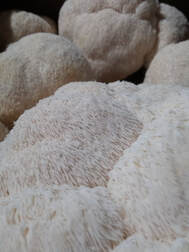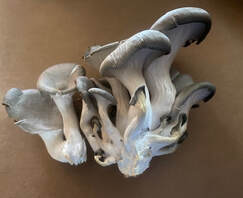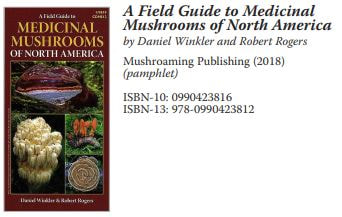Wikipedia defines medicinal fungi as “fungi that contain metabolites, or can be induced to make metabolites through biotechnology that can be used to develop prescription drugs.” The naturally occurring compounds in many fungi that have made them important in traditional medicine throughout the world for many years.
TRADITIONAL USES OF MUSHROOMS
Robert Rogers notes in his book, The Fungal Pharmacy, that over 250 fungal species are believed to have therapeutic effects. Below is a short list of a few traditional uses of mushrooms.
- In 2017 scientists analyzed the contents of a 50,000 year old Neanderthal’s stomach, and found evidence of a penicillin producing mold that he may have been taking for a badly abscessed tooth.
- Otzi, the Ice Man, whose mummy was preserved in glacial ice in the Austrian Alps, was carrying the tinder polypore, Fomes fomentarius, and Fomitopsis betulina, the birch polypore. It is likely he was carrying the tinder polypore as a fire starter, but scientists are speculating that he carried the birch polypore to treat a bad case of intestinal parasites.
- The Jewish Talmud references the use of Chamka, a concoction of moldy corn mash soaked in date wine to heal wounds.
- Ancient Egyptians recorded the use of moldy bread to prevent infections in burns.
- Ganoderma lucidum, the reishi mushroom was revered in ancient China and Japan as a way to increase longevity, and treat asthma, bronchitis, nephritis and hypertension.
- Chaga, Inonotus obliquus, has been used for centuries by people from Eastern Europe, Russia, Scandinavia and some indigenous people of British Columbia to treat cancer and stomach complaints.
FUNGI AS PHARMACEUTICALS
In 1928, Alexander Flemming, discovered a method to isolate penicillin from bread mold creating the first bioengineered antibiotic. This discovery has saved countless lives, and opened the door to many new therapies.
Since then pharmaceutical research has identified many compounds from fungi that contain antibacterial, antiviral, immunosuppressant, anticancer, anti-fungal, psychotropic and cholesterol lowering properties. Some of the better known examples of these include:
Many traditional fungal treatments are based on anecdotal evidence, and not backed by research. For example, Paul Stamets has claimed that Trametes versicolor cured his mother’s advanced breast cancer, but he fails to mention that she was also taking Taxol, which is a Medicinal Mushrooms known medical treatment for breast cancer. There may very well be valid therapeutic uses for cultivated or naturally occurring fungi, but rigorous scientific research needs to be done. Be wary of spending large amounts of money on unproven fungal cures that are available online and in health food stores. In the meantime, edible fungi are nutritious and delicious additions to our diet. They are rich in vitamins, minerals and amino acid, and may also have some wonderful health benefits. Eating fresh fungi like shiitake mushrooms or Grifola frondosa may help modulate blood pressure or promote anti-tumor activity, but that is not the primary reasons for consuming these natural powerhouses. Fungi are a tasty addition to a healthy diet.
Since then pharmaceutical research has identified many compounds from fungi that contain antibacterial, antiviral, immunosuppressant, anticancer, anti-fungal, psychotropic and cholesterol lowering properties. Some of the better known examples of these include:
- Cyclosporine which is used to prevent organ rejection after transplants
- Statins such as Lipitor to lower cholesterol levels
- Taxol is produced by endophytic fungi in the Pacific Yew Tree is used to treat breast, ovarian and uterine cancers.
- Griseofulvin is an anti-fungal derived from competing fungal species.
- Psilocybin is speculated to treat depression, alcoholism and anxiety, but needs more scientific studies to document its effectiveness.
- Fingolimod (Galinya) is used as an oral immune suppressant to treat multiple sclerosis.
Many traditional fungal treatments are based on anecdotal evidence, and not backed by research. For example, Paul Stamets has claimed that Trametes versicolor cured his mother’s advanced breast cancer, but he fails to mention that she was also taking Taxol, which is a Medicinal Mushrooms known medical treatment for breast cancer. There may very well be valid therapeutic uses for cultivated or naturally occurring fungi, but rigorous scientific research needs to be done. Be wary of spending large amounts of money on unproven fungal cures that are available online and in health food stores. In the meantime, edible fungi are nutritious and delicious additions to our diet. They are rich in vitamins, minerals and amino acid, and may also have some wonderful health benefits. Eating fresh fungi like shiitake mushrooms or Grifola frondosa may help modulate blood pressure or promote anti-tumor activity, but that is not the primary reasons for consuming these natural powerhouses. Fungi are a tasty addition to a healthy diet.
FUNGI WITH MEDICINAL PROPERTIES
Below is a short list of fungi thought to have medicinal properties. NJMA does not recommend treating health conditions with fungi, although interested people are encouraged to do their own research into how fungi may enhance their health. Always consult your medial professional before using fungi to treat health conditions since some compounds may interact with medications. Many species are a valuable source of nutrition, and may also have health benefits. Be sure to thoroughly cook all wild fungi before consuming and use in moderation. Be certain of your ID before ingesting any fungus as some common edibles may have poisonous look alikes.
Inonotus obliquus (CHAGA)
|
Inonotus obliquus (Chaga) is a parasitic canker in the Hymenochaetacea family growing most commonly on birch trees in boreal forests. The sterile black, cracked conk has an orange brown interior and looks like burned charcoal. This fungi has been used for centuries for its anti-cancer properties and is currently being studied at Sloan Kettering in New York for its therapeutic value.
|
Ganoderma lucidum (REISHI OR LING CHI)
|
Ganoderma lucidum (Reishi or Ling Chi) is soft red-varnished, kidney shaped polypore with white to dull brown spores growing on deciduous trees. It is the “mushroom of immortality” revered by the ancient Chinese and Japanese.
|
Trametes versicolor (Turkey Tail Fungus)
|
Trametes versicolor (Turkey Tail Fungus) is a small, thin, velvety, kidney shaped polypore that is has variable colors from reddish brown, yellows, blue, green or tan. The white pore surface has many very tiny pores that might need magnification to be observed. There are many look alikes.
|
Grifola frondosa ( Hen of the woods or Maitake)
|
Grifola frondosa (Hen of the woods or Maitake) is a polypore growing at the base of stumps or hardwood trees, especially oak. The fruiting body which can be very large, consists of grayish-brown, spoon shaped caps with a white pore surface arising from a compound base. The fungi is named for its resemblance to a hen’s tail, and is easily disguised by the leaves surrounding it. Foragers treasure this mushroom for its flavor and texture.
|
Lentinula edodes (Shiitake)
|
Lentinula edodes (Shiitake) is a delicious, widely cultivated mushroom growing on oak or oak sawdust. Shiitake is a gilled tan to brown gilled mushroom with pale cream gills native to Japan, Korea and China. Shiitakes are rich in selenium, and copper, a mineral that supports blood vessels and the immune system.
|
Hericium erinaceus (Lions Mane)
|
Hericium erinaceus (Lions Mane) is a large, white, shaggy fungi resembling a lion’s mane as they grow on wood. Hericium means hedgehog in Latin. They are a delicious edible that contains, hericenones and erinacines, two compounds that may boost the growth of brain cells.
|
Pleurotus SP. (OYSTER MUSHROOMS)
Cordyceps SP.
|
Cordyceps is a genus of parasitic fungi that grow on insects.
|
References
- Christopher Hobbs, Medicinal Mushrooms, An Exploration of Tradition, Healing and Culture, Botanica Press, 2002
- Robert Rogers, The Fungal Pharmacy, The Complete Guide to Medicinal Mushrooms and Lichens of North America, North Atlantic Press, 2011.
- Sheldrake, Merlin, Entangled Life: How Fungi Make our Worlds, Change our Minds, and Shape our Futures, Penguin Random House, 2020.
- Winkler, Daniel and Rogers, Robert, A Field Guide to Medicinal Mushrooms of North America, Mushroaming Publishing, 2018
- Some valuable online resources for investigation potential health benefits of fungi: www.webmd.com and www.healthline.com
- Instruction on making hot water and double extraction tinctures can be found on the internet.
















